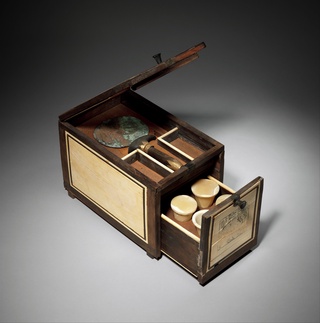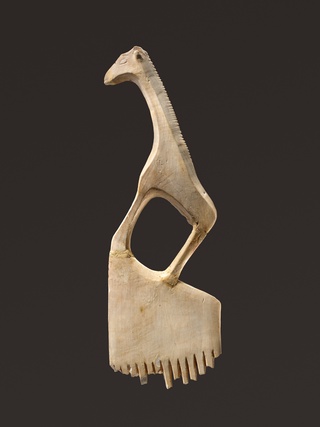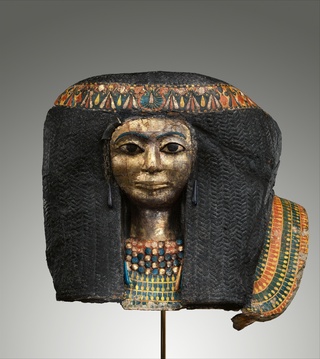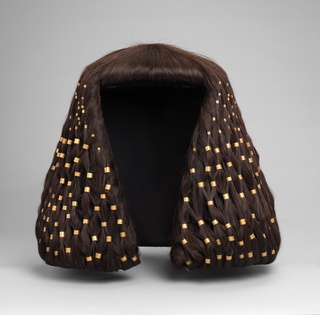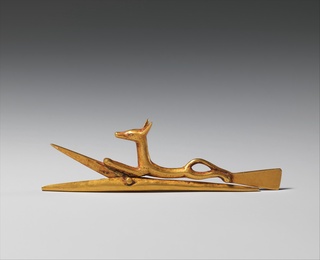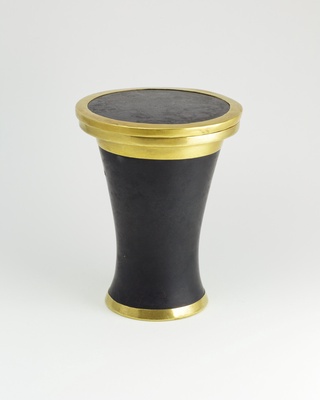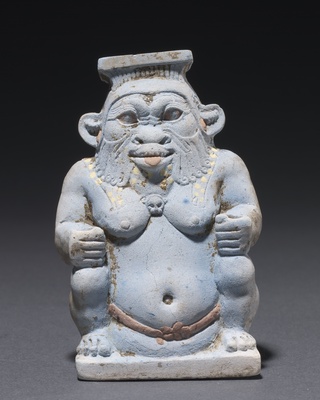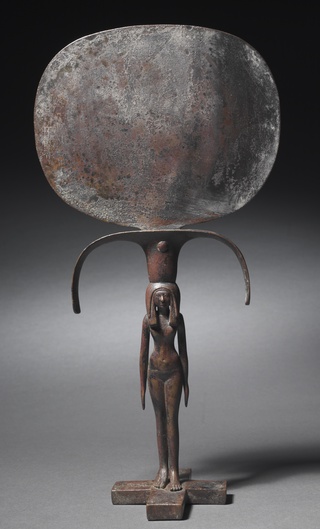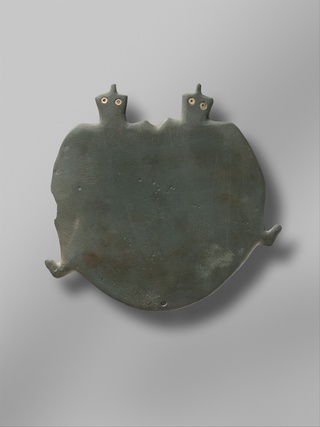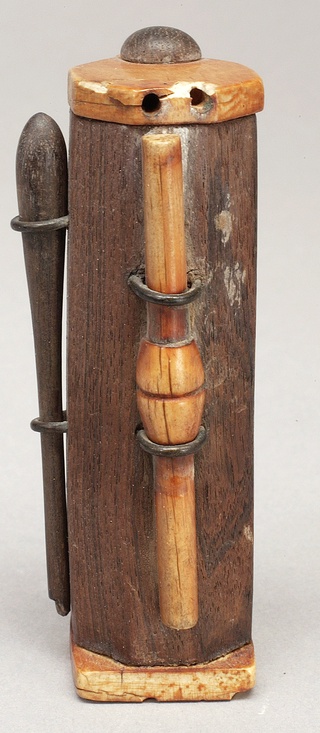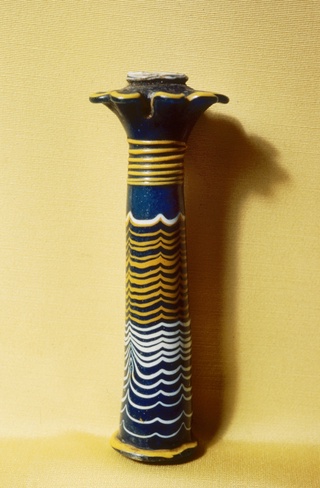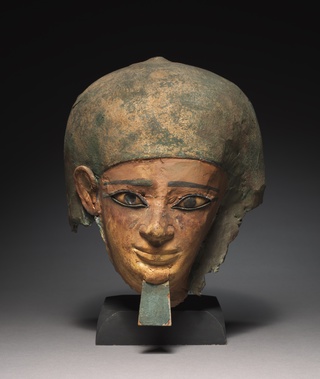Hair and Makeup in Ancient Egypt
By Reina Gattuso•July 2022•10 Minute Read
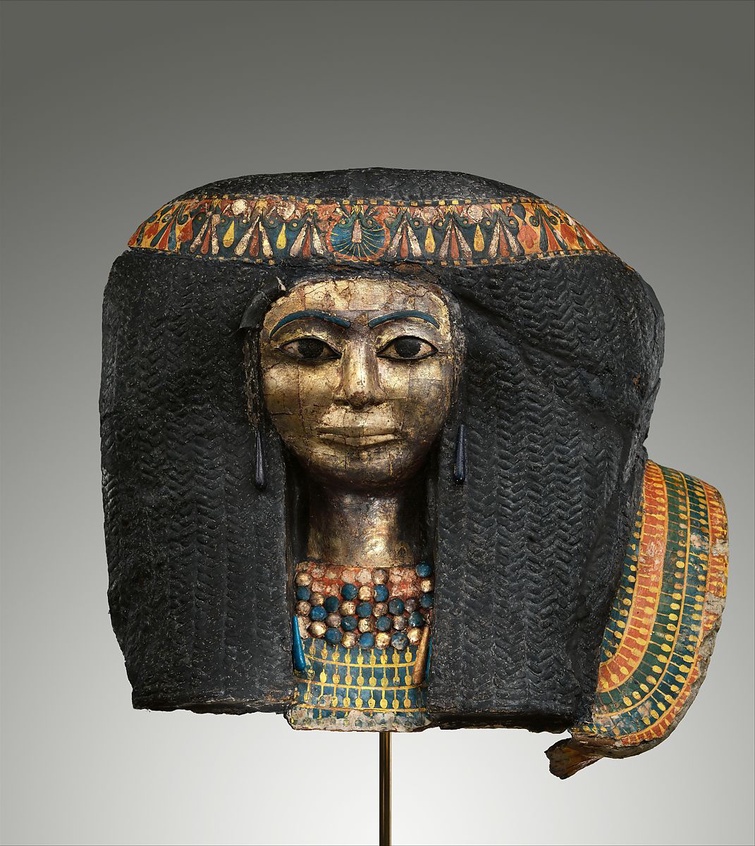
Unknown, Funerary Mask of a Woman, ca. 1427–1390 BCE, New Kingdom, Egypt. Metropolitan Museum of Art. Egyptian funerary masks ensured the deceased's safe passage into the afterlife.
The smokey eye makeup look isn’t a modern invention. Ancient Egyptians painted their lips, applied eyeshadow, and lined their eyes more than four thousand years ago. By studying makeup and hair-related artifacts, contemporary people can better understand ancient Egyptians’ beliefs connecting beauty, fertility, and everlasting life.
Introduction
When archaeologists excavated the tomb of Kemeni, royal butler to ancient Egyptian pharaoh Amenemhat IV, they found an elaborate cedar and ivory box.
The drawer held cutouts that archaeologists deduced were meant for ointment jars. The box had a compartment in the shape of a hand mirror. It was Kemeni’s cosmetics box.1
Archaeologists commonly find cosmetics vessels, makeup containers, and hair ornaments in ancient Egyptian tombs. Just like many people today, Egyptians of all genders invested time and resources in their makeup, hair, and skincare.
Ancient Egyptians used makeup and hair accessories to beautify themselves according to standards of the day. But cosmetics were also practical. Kohl eyeliner, made with poisonous lead, protected their eyes from infection2 and sunglare.3 Wigs protected them from lice.4
Cosmetics also served a spiritual function. Ancient Egyptians decorated cosmetics vessels with symbols of fertility and regeneration. Elite Egyptians included makeup among their funerary objects. They believed that people had to be reborn through sexual reproduction after death in order to enter the afterlife.5 Looking alluring was important even in the grave.
Egyptian hair and makeup accessories from the predynastic period to the Ptolemaic period demonstrate the spiritual, aesthetic, and practical importance of beauty. They also provide an early history of many of the adornments, like eyeliner and wigs, that people worldwide still use today.
Hair
Ancient Egyptians used tools to remove unwanted hair, plus wigs and adornments to augment natural hair.
Decorative combs are some of the oldest hair accessories archaeologists have found. Many are made of ivory and have elaborate animal motifs.
Combs from women’s tombs dating as early as 3900 BCE show designs including giraffes, ostriches, and wildebeests. Scholars speculate that these detailed depictions of local animals may be related to ritualistic hunting and that women may have worn them at festivals.6
Archaeologists have evidence of ancient Egyptians of all genders and classes wearing wigs as early as 3400 BCE.7 Some Egyptians removed their natural hair altogether. Others kept their hair cropped and wore wigs over it. Wigs guarded wearers’ natural hair from lice. Priests in particular kept their heads shaved, as lice would have interfered with their ritual purity.8
Several ancient Egyptian wigs survive today in museum collections. Archaeologists found a wig, pictured here, in the tomb of Nauny, a priestess from around 1000 BCE.
The finest Egyptian wigs were made of human hair, though wigmakers also used plant fibers. Ancient Egyptian hairdressers and wigmakers skillfully braided human hair into dozens of small plaits to make wigs. Elite men sometimes wore artificially curled hair layered over braids in ornate double-decker wigs. Wigmakers used beeswax and animal fat to set the styles.9
Egyptians sometimes wore hair extensions in their natural hair rather than full wigs.10 They also put precious adornments in their hairpieces, like these gold wig rings.
Archaeologists found wig rings in the coffin of Sithathoriunet, a princess who lived in the 1800s BCE. The wig they beautified had deteriorated, but art historians reconstructed their likely use based on tomb paintings.11
Ancient Egyptians also practiced hair removal by tweezing and shaving. Men usually kept their beards trim or clean-shaven. Both men and women removed body hair using different potions, such as blood from a hound’s vulva, and with a honey-sugar mixture, which people still use today.12 13
Archaeologists speculate that ancient Egyptians used a commonly found tool as a dual tweezer and razor. The instruments may also may have served as tongs for hair curling.14
Beauty Kits
Elite ancient Egyptians like Kemeni owned full skincare kits with cosmetics boxes that contain jars of ointments, scented oils, and hand mirrors.
Ancient Egyptians used scented oils for bathing, softening skin, and deodorant. Princess Sithathoriunet’s tomb contained a precious gold and obsidian ointment beaker.
Ancient Egyptians found fragrances and body oils very erotic. They associated smooth, perfumed skin with beauty and sexuality—and thus with fertility and regeneration. Thus, artists often made cosmetics accouterments in the form of symbols of rebirth.
Bes was the god of childbirth, humor, and war, and he protected pregnant women and infants. He was also the god of cosmetics, demonstrating the conceptual overlap between beauty and pregnancy.15 Artists depicted him on cosmetics jars.
Mirrors symbolized life. Artisans made them from disks of copper, or sometimes silver or gold, polished to a shine. Their round reflective surfaces resembled the primordial sun, whose rising heralded the creation of the world.16 Mirrors usually had handles meant to mimic the shape of a papyrus stem, which the Egyptians associated with fertility and eroticism.17
Artists sometimes made mirrors in the shape of a devotee, or nefrut, of the goddess Hathor.
Makeup
After bathing and oiling their bodies, ancient Egyptians applied cosmetics. Egyptians of all genders wore kohl eyeliner, and applied pigments to their cheeks and lips. Kohl was primarily worn by the rich, as it was quite expensive. Peasants lined their eyes with less expensive materials.18
Makeup Palettes
Egyptians mixed colored minerals with oils on stone palettes to make lipstick and blush. They used crushed malachite for green eyeshadow and crushed ochre for reddish eye shadow. They also used red ochre on the cheeks and lips.19 20
Archaeologists have found many stone makeup palettes in animal shapes from the predynastic period. The animals typically have an association with fertility and regeneration, reinforcing the spiritual significance of cosmetics use. For example, the motif of mating mud turtles, which were native to the Nile, represented regeneration, as well as both chaos and a protective force.21
Artists made cosmetics palettes in the shape of tilapia, which also lived in the Nile. The fish hold their eggs in their mouths before they hatch. Because of this, Egyptians believed that tilapia spontaneously generated new life. They associated them with Hathor and Re, the sun god.
Unknown, Cosmetic Dish in the Shape of a Bolti Fish, ca. 1479–1425 BCE. Metropolitan Museum of Art. Cosmetic palettes in the shape of bolti fish were popular in the Predynastic period.
Archaeologists have also found many cosmetics spoons. These tend to have long, ornate handles and shallow bowls with attached lids. Scholars believe that ancient Egyptians used them to store or mix cosmetics.22
The cosmetic spoon pictured here represents a woman swimming. She’s holding on to a gazelle, which forms the bowl of the spoon. Some scholars speculate the gazelle is her pet.23
Kohl Sets
Ancient Egyptians often lined their eyes with kohl. They crushed galena and lead and mixed it with fat and oil to make kohl.24 Elites often kept kohl in sets consisting of a tube and stick.
Ancient Egyptians used kohl to emphasize the eyes and protect them from sunglare. They also believed that kohl helped fight eye infection. Modern scientists have found that the lead in kohl indeed has antimicrobial effects, though it is toxic.25
Glass kohl tubes were all the rage in New Kingdom Egypt. Glassmakers designed them to resemble palm-shaped columns, a common Egyptian architectural element.
People of all genders wore kohl. For example, this is the funeral mask of a male Middle Kingdom scribe, Kenbi, with lined eyes.
Ancient Egyptian Beauty Today
In the 19th and 20th centuries, archaeologists and looters, many of them part of European colonial power structures, resurfaced many ancient Egyptian artifacts—for example, the bust of Queen Nefertiti. This inspired a European and American craze for all things ancient Egyptian. Europeans and Americans produced “Egyptian-inspired” decor, fashion, architecture, and film through a Eurocentric, colonial lens.[^26][^27] In contrast, African and African diasporic contemporary artists have used images of Nefertiti to reclaim depictions of African beauty.
In Egypt and around the world, people continue to use kohl and other cosmetics, both for beauty and ritual protection.28 Most contemporary cultures do not share ancient Egyptians’ beliefs that physical beauty leads to spiritual immortality. Yet we have only to view a makeup advertisement to see that contemporary people continue to associate cosmetics with the desire for eternal life.
Reina Gattuso is a content writer on the Curationist team, and an independent journalist covering gender and sexuality, arts and culture, and food. Her journalism connects analysis of structural inequality to everyday stories of community, creativity, and care. Her work has appeared at Atlas Obscura, The Washington Post, Teen Vogue, The Lily, POPSUGAR, and more. Reina has an MA in Arts and Aesthetics (cinema, performance, and visual studies) from Jawaharlal Nehru University in New Delhi, India, where her research focused on sexuality in Hindi film. She writes and teaches writing to high school students in New York City.
Citations
Killen, Geoffrey. Ancient Egyptian Furniture, Oxbow Books, 2017, pp. 32. Google Books, https://www.google.com/books/edition/Ancient_Egyptian_Furniture/N7IuDgAAQBAJ?hl=en&gbpv=1&dq=kemeni&pg=PA32&printsec=frontcover. Accessed 15 April 2022.
“Ancient Egyptian cosmetics: ‘Magical’ makeup may have been medicine for eye disease.” American Chemical Society, 11 January 2010, https://www.acs.org/content/acs/en/pressroom/newsreleases/2010/january/ancient-egyptian-cosmetics.html. Accessed 15 April 2022.
“Footed Kohl Pot with Lid.” Brooklyn Museum, https://www.brooklynmuseum.org/opencollection/objects/4034. Accessed 15 April 2022.
“Ancient Egyptian Art.” Brooklyn Museum, https://www.brooklynmuseum.org/opencollection/exhibitions/3329. Accessed 15 April 2022.
“A Woman’s Afterlife: Gender Transformation in Ancient Egypt.” Brooklyn Museum, https://www.brooklynmuseum.org/exhibitions/womans_afterlife_ancient_egypt. Accessed 16 April 2022.
Patch, Diana Craig. Dawn of Egyptian Art, The Metropolitan Museum of Art, 2012, pp. 59, https://www.metmuseum.org/art/metpublications/Dawn_of_Egyptian_Art. Accessed 16 April 2022.
Fletcher, Joann. “The Most Democratic Form of Adornment.” Rawi, https://rawi-magazine.com/articles/hair/. Accessed 16 April 2022.
Fletcher, Joann and Filippo Salamone. “An Ancient Egyptian Wig: Construction and Reconstruction.” Internet Archaeology 42, 2016. http://dx.doi.org/10.11141/ia.42.6.3. Accessed 16 April 2022.
“The Most Democratic Form of Adornment.”
“The Most Democratic Form of Adornment.”
“Wig Rings of Sithathoryunet, on a Modern Wig.” The Metropolitan Museum of Art, https://www.metmuseum.org/art/collection/search/656816. Accessed 16 April 2022.
“Hair Removal.” University of Wales Swansea, https://www.egypt.swan.ac.uk/the-collection-2/the-collection/hair-removal/. Accessed 16 April 2022.
Black, Riley. “Makeup in Ancient Egypt.” Natural History Museum of Utah, 30 June 2021, https://nhmu.utah.edu/blog/2021/06/30/makeup-ancient-egypt. Accessed 16 April 2022.
“Hair Curler in the Form of a Woman.” Brooklyn Museum, https://www.brooklynmuseum.org/opencollection/objects/4079. Accessed 16 April 2022.
“Cosmetic Jar in the Form of the God Bes.” The Cleveland Museum of Art, https://www.clevelandart.org/art/1995.13. Accessed 16 April 2022.
“Mirror with Handle in Form of Girl.” Brooklyn Museum, https://www.brooklynmuseum.org/opencollection/objects/3682. Accessed 16 April 2022.
Kamrin, Janice. “Papyrus in Ancient Egypt.” The Metropolitan Museum of Art, March 2015, https://www.metmuseum.org/toah/hd/papy/hd_papy.htm. Accessed 26 May 2022.
Mark, Joshua J. “Cosmetics, Perfume, & Hygiene in Ancient Egypt.” World History Encyclopedia, 4 May 2017, https://www.worldhistory.org/article/1061/cosmetics-perfume--hygiene-in-ancient-egypt/. Accessed 19 April 2022.
Shaw, Gary. “Looking Great for Eternity: Predynastic Cosmetic Palettes.” Rawi, https://rawi-magazine.com/articles/predynastic_palettes/. Accessed 16 April 2022.
El-Kilany, Engy and Enas Raoof. “Facial Cosmetics in Ancient Egypt.” Egyptian Journal of Tourism Studies, vol. 16, no. 1, Nov. 2017, https://www.academia.edu/33510332/Facial_Cosmetics_in_Ancient_Egypt_By. Accessed 27 April 2022.
“Palette Depicting a Pair of Mud Turtles.” The Metropolitan Museum of Art, https://www.metmuseum.org/art/collection/search/544044. Accessed 16 April 2022.
“Dancing Girl Cosmetic Spoon.” Petrie Museum, University College London, https://www.ucl.ac.uk/culture/petrie-museum/dancing-girl-cosmetic-spoon. Accessed 16 April 2022.
Scott, Nora E. The Daily Life of the Ancient Egyptians, The Metropolitan Museum of Art, 1973, https://resources.metmuseum.org/resources/metpublications/pdf/The_Daily_Life_of_the_Ancient_Egyptians_The_Metropolitan_Museum_of_Art_Bulletin_v_31_no_3_Spring_1973.pdf. Accessed 16 April 2022.
Lunn, Hazel. “Cleopatra’s Eye: The Significance of Kohl in Ancient Egypt.” The Recipes Project, 27 November 2018, https://recipes.hypotheses.org/12837. Accessed 16 April 2022.
“Ancient Egyptian cosmetics: 'Magical' makeup may have been medicine for eye disease.” American Chemical Society, 11 January 2010, https://www.acs.org/content/acs/en/pressroom/newsreleases/2010/january/ancient-egyptian-cosmetics.html. Accessed 15 April 2022.
Blouin, Katherine et al. “How Academics, Egyptologists, and Even Melania Trump Benefit from Colonialist Cosplay.” Hyperallergic, 22 October 2020, https://hyperallergic.com/595896/how-academics-egyptologists-and-even-melania-trump-benefit-from-colonialist-cosplay/. Accessed 20 April 2022.
Cohen, Alina. “How Millennia of Cleopatra Portrayals Reveal Evolving Perceptions of Sex, Women, and Race.” Artsy, 6 May 2018, https://www.artsy.net/article/artsy-editorial-millennia-cleopatra-portrayals-reveal-evolving-perceptions-sex-women-race. Accessed 16 April 2022.
“Kohl (cosmetics).” Wikipedia, https://en.wikipedia.org/wiki/Kohl_(cosmetics). Accessed 16 April 2022.
Reina Gattuso is a content writer on the Curationist team, and an independent journalist covering gender and sexuality, arts and culture, and food. Her journalism connects analysis of structural inequality to everyday stories of community, creativity, and care. Her work has appeared at Atlas Obscura, The Washington Post, Teen Vogue, The Lily, POPSUGAR, and more. Reina has an MA in Arts and Aesthetics (cinema, performance, and visual studies) from Jawaharlal Nehru University in New Delhi, India, where her research focused on sexuality in Hindi film. She writes and teaches writing to high school students in New York City.
